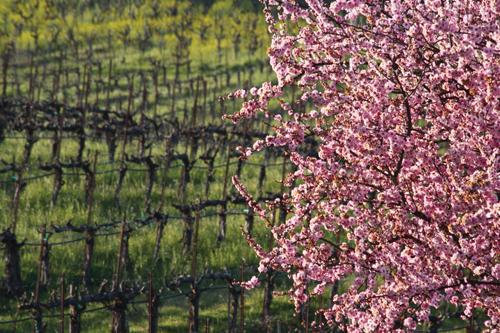This year, January’s showers brought February flowers, likely
signaling an early start to winegrape growth and a rocky start for
local orchards.
“A warm spell like we just had will definitely affect the fruit
trees. It causes some of the earlier blooming varieties to bloom
now when there’s no bees out, and therefore no pollination gets
done and it cuts way down on the amount of fruit that is produced,”
said Phil Pieri, head of the Redwood Empire Chapter of the
California Rare Fruit Growers.
Until the rain that fell on Valentine’s Day, February felt far
more like spring than winter. While snow piled up on the eastern
seaboard, Sonoma County temperatures flirted with the low 80s,
tricking some flora into coming out of hibernation early.
The temperature first pushed past 80 degrees on February 5,
reaching a high 20 degrees above the normal value for the date. In
fact, temperatures shattered records for three days straight: the
81 degree temperature on February 6 broke a record that stretched
back nearly a century.
Because of the dry heat, grapegrowers are anticipating bud break
to begin earlier than usual.
“I think that the odds are for earlier than normal, rather than
normal, or later than normal,” said Nick Frey, president of the
Sonoma County Winegrape Commission. “I think it’s likely to be
early, but probably the weather in the next couple of weeks will be
key. Sounds like it’s going to be pretty cold, so that’s definitely
going to slow things down.”
Duff Bevill of Bevill Vineyard Management noted that the typical
signs of impending bud break—sap flowing through the vines, certain
tree varieties leafing and blooming—have appeared a touch
early.
“We always look around for other signs. Some people used to look
at certain species of willow trees, and everyone’s looking at the
flowering plums around the county. All that stuff is a little bit
early. Flowering plums, for example, are usually in full bloom
somewhere about the 15th to the 20th, and most of them are already
in full bloom now [Feb. 14], and started blooming a week ago. So
that’s earlier than what we like to think of as normal,” Bevill
said.
“The other measurement is that buds are starting to swell in
early varieties. I’ve heard that some people started noticing it
about a week ago, although I don’t know specifically what variety
or from where. And as we’ve continued pruning, they’ve been
bleeding,” Bevill said.
An earlier bud break could mean a slightly longer frost
protection season, and long-range forecast models are predicting a
cool, dry spring based on the tail end of a La Nina weather
pattern.
“Temperatures are expected to be below normal. It could have an
effect on the frost season this year, with less rainfall, clear
nights, and cooler temperatures,” said Don Schukraft, CEO and
Certified Consulting Meteorologist with Western Weather Group.
“We’re in that transition zone between above normal rainfall to
the north of us and below normal rainfall to the south. As these
storms come into the Pacific Northwest, the question will be how
far south they extend. At this point, since we’re in the transition
zone, we are probably going to see near-normal rainfall the rest of
the winter, but then the spring could be below normal rainfall,”
Schukraft said.
A cool, cloudless spring could necessitate greater frost
protection measures from vineyard owners, but perhaps offer some
bright news for orchardists.
“I would prefer that the temperatures stayed below 45 degrees
until sometime in March when the chances of cold weather are past
and the flowers can come out normally, and the bees will be out,
and then we’ll get more production from the trees,” orchardist
Pieri said.
In short, the unusual weather patterns of 2011 are shaping up to
create a year unlike any other year, just like every other year.
Natural climactic variety is the spice of local agriculture—and
what gives each vintage of wine its defining characteristics.
“Normal is always different. That’s what normal,” Bevill said.
“It’s just a parameter.”
Staff writer Lynda Hopkins can be reached at
Ly***@hb*****.com
.
51.9
F
Healdsburg
November 25, 2024








